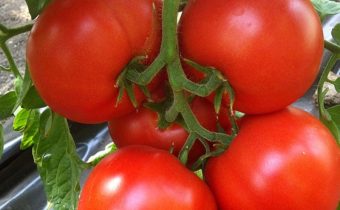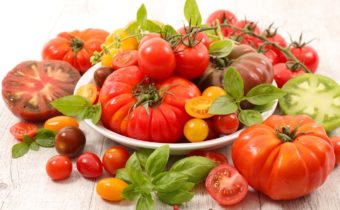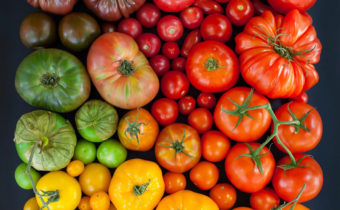Tomato "Polar precocious": impressive for its qualities
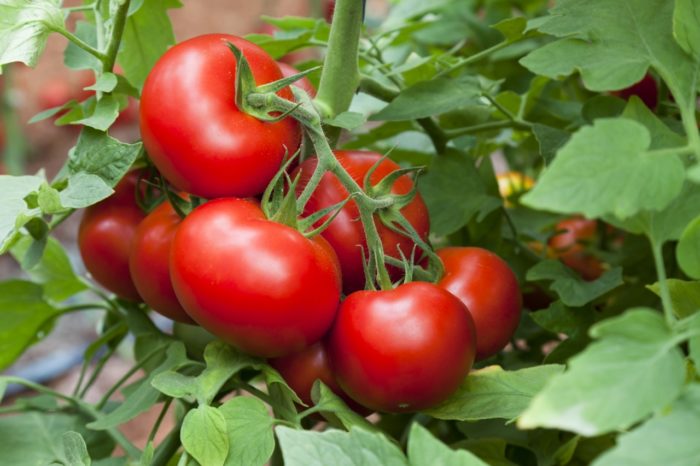
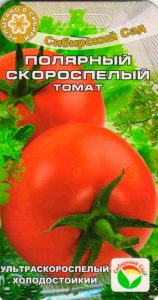 Several decades ago, for the cold central and northern regions of Russia, breeders developed an interesting and cold-resistant tomato variety, Polar Early. Reviews, photos, yields impress many who planted this variety. The good taste of the fruit, unpretentiousness and cold resistance make it a favorite of gardeners. Given the Polar Early Maturing Interest in Tomato, the characteristics and description of the variety will reveal the mystery of this long-time “inhabitant” of summer cottages and personal plots.
Several decades ago, for the cold central and northern regions of Russia, breeders developed an interesting and cold-resistant tomato variety, Polar Early. Reviews, photos, yields impress many who planted this variety. The good taste of the fruit, unpretentiousness and cold resistance make it a favorite of gardeners. Given the Polar Early Maturing Interest in Tomato, the characteristics and description of the variety will reveal the mystery of this long-time “inhabitant” of summer cottages and personal plots.
Description of the bush
Tomato Polar early ripening, determinant, undersized variety. One of the earliest tomatoes. The time from germination to the first fruits is only 110-112 days. The bush is small, up to 70 cm high. The leaves are small and there are not very many of them on the bushes. This allows the fruit to get more solar energy.
Fruit Description
 The fruits of this variety are red in a rounded-flat form, weighing 60-100 g. Sometimes, with good care, their weight reaches 150-160 g. The fruits have from 7 to 12 chambers. The percentage of dry matter comes to 7. The taste of tomatoes is traditional. Pleasant sweetness with sourness, allowed this variety to take its place in areas of many gardeners.
The fruits of this variety are red in a rounded-flat form, weighing 60-100 g. Sometimes, with good care, their weight reaches 150-160 g. The fruits have from 7 to 12 chambers. The percentage of dry matter comes to 7. The taste of tomatoes is traditional. Pleasant sweetness with sourness, allowed this variety to take its place in areas of many gardeners.
Grade assignment
The variety has a universal purpose. Due to its good taste, it is beautiful fresh, both separately and in salads with other vegetables. In addition, due to its small size, it is ideal for canning and processing.
See also: Tomato "Giant Novikova" with excellent taste
Disease resistance
Growing a tomato Polar early, do not neglect preventive measures to combat pests and diseases. Indeed, despite the relative resistance to certain diseases, it is difficult for a plant to resist pests and microbes.
In addition to chemicals, gardeners often use traditional methods of struggle. Infusions of various herbs, garlic and onions. Planting among the marigold beds or marigolds and much more.
Advantages and disadvantages
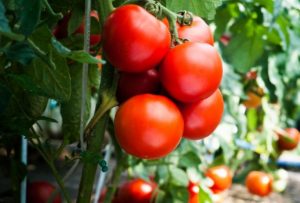 Long-term cultivation of tomatoes of this variety suggests that it is competitive and not inferior in its qualities to varieties that are derived much later.
Long-term cultivation of tomatoes of this variety suggests that it is competitive and not inferior in its qualities to varieties that are derived much later.
The main advantages of early-growing tomato tomato are:
- high yield, which reaches 1.5 kg. When planting 6-7 bushes per m2 yield can reach up to 10 kg;
- the ability of the plucked fruits to “reach” to the necessary degree of ripening, being plucked in milky ripeness;
- friendly return of the crop:
- resistance to temperature and cold snaps. This enables this variety in regions with a cold climate not only in greenhouses, but also in open ground;
- the versatility of the fruit. They are good, both fresh and processed;
- thanks to ripening, you can quickly collect and process the fruit. This variety is excellent as in pickled or canned form, and for the preparation of juices and mashed potatoes;
- resistance to such diseases as brown spot and tobacco mosaic makes this variety very attractive for tomato lovers.
The disadvantages of the variety include:
- uneven fruit by weight and shape;
- noncompetitive compared to new hybrids;
- poor responsiveness to new farming practices.
See also: Honey Giant Tomato: Large and Fruitful
Features of growing varieties
Despite the fact that this variety is an old-timer on garden beds, it still has some peculiarities. Therefore it is necessary to understand what he has for so many years so stubbornly won the hearts of gardeners.
Recommended growing regions
Due to its qualities, the Polar early-growing tomato is grown in many central and northern regions of Russia. The exception is the southern regions and the North Caucasus.
Growing seedlings
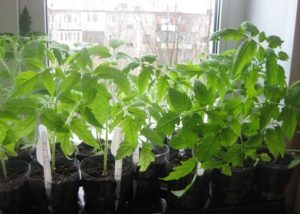 Given that the summer in the northern regions is not so long, it is preferable to grow this variety of tomatoes through seedlings.
Given that the summer in the northern regions is not so long, it is preferable to grow this variety of tomatoes through seedlings.
The best period for sowing seeds is the last decade of February. To do this, in the boxes or boxes poured in the same amount of humus and peat. Moisturize the soil and sow the seeds. Then sprinkle with a mixture of soil so that the seed was at a depth of 1 cm. After that, the boxes can be covered with glass or film.
If the plants dive, then in the phase of the first true leaf it is necessary to do this. If the plants are grown without picking, then after the appearance of these leaves, young seedlings are fed ammonium nitrate. Further care of the seedlings consists of systematic watering and regular fertilizing.
Transplant into the ground
When the plant grows to a height of 20-25 cm and the first brush with buds appears, then in good weather they can be planted in open ground. This usually occurs in late May and early June.
If possible, it is better to plant plants under temporary shelter. This will further protect the seedlings from cold and temperature changes. In addition, it will create conditions for better fruiting, and will accelerate the ripening of fruits for 2 weeks.
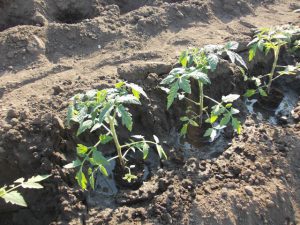 If this is not possible, then the seedlings are planted in the open ground at the onset of a stable positive temperature. For different regions, the drop-off period may vary.
If this is not possible, then the seedlings are planted in the open ground at the onset of a stable positive temperature. For different regions, the drop-off period may vary.
For planting seedlings in advance prepare the place. The best predecessor for tomatoes are legumes, onions, cucumbers. In addition, you need to ensure that future bushes receive maximum heat and light, which means that no shadow should fall on the bottom and at the same time they should be protected from the wind. After all these factors are taken into account, you can start planting seedlings.
See also: A series of tomatoes "Hybrid Tarasenko": a description of varieties
Care
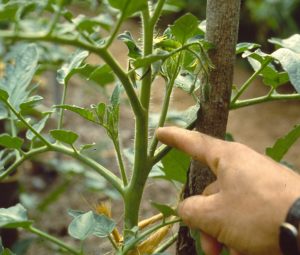 When the plants take root, after about 10-14 days, carry out the first feeding with mineral or organic fertilizers. Grown up and grown bushes need to form 2-3 stalks (depending on the density of planting) and systematically tear off all the extra stepchildren, leaving a small “penulech”.
When the plants take root, after about 10-14 days, carry out the first feeding with mineral or organic fertilizers. Grown up and grown bushes need to form 2-3 stalks (depending on the density of planting) and systematically tear off all the extra stepchildren, leaving a small “penulech”.
Further care with tomatoes is reduced to watering, fertilizing, protection from pests and loosening the soil. To prevent contact of the fruit with the soil, tomato stalks are tied to stakes. This will improve the flow of bushes, and thus reduce the likelihood of disease from excessive dampness.
During the period of plant growth, preventive measures should be taken to prevent diseases or attack pests. When using products of industrial production, it is necessary to strictly adhere to the instructions for use, and not to use vegetables before the maximum permissible flow after using chemicals.
Video: 9 secrets of fruitful tomatoes


